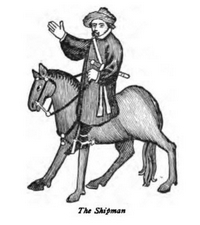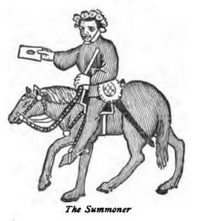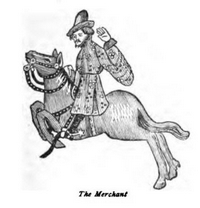Religious and Secular Literature in Middle English
This is part 2 of a section about Middle English

About the year 1200 Wace's poem was translated into English by Layamon, a priest of Arley Regis, on the Severn. Layamon's Brut is in 30,000 lines, partly alliterative and partly rhymed. The style is rude but vigorous, and at times highly imaginative. The of Arthur, however, received its fullest development in a series of French romances, composed partly in France and partly in England in the latter part of the twelfth cen-
The English paraphrases and imitations of the French metrical chivalry tales are interesting for their illustrations of manners and ideals in the Middle Ages, but they have very little literary art. The French trouvere told his story in a straightforward, prosaic fashion, omitting no details in the action and unrolling endless descriptions of dresses, trappings, gardens, etc. His romance sometimes extended to thirty, forty, or fifty thousand lines. The English paraphrases had usually the prolixity of the originals, with greater rudeness of style and verse. The romances, however, abound in situations and characters, of which the poets of a more artistic though less inventive age have made a noble use -- poets such as Tennyson, Swinburne, Matthew Arnold, and William Morris.
With the discontinuance of the Anglo-Saxon Chronicle, English history written in English prose ceased for 300 years. The thread of the nation's story was kept up in Latin chronicles, compiled by writers partly of Norman and partly of English blood. The earliest of these, such as Ordericus Vitalis, Simeon of Durham, Henry of Huntingdon, and William of Malmesbury, were contemporary with the later entries of the Saxon Chronicle. The last of them, Matthew of Westminster, finished his work in 1273. About 1300 Robert, a monk of Gloucester, composed a chronicle in English verse, following in the main the authority of the Latin chronicles; and he was succeeded by other rhyming chroniclers, the most important of whom was Robert Manning, a priest of Brunne (now Bourn), in Lincolnshire, whose History of England was finished in 1338. In these chronicles the line between fact and fable was gradually obliterated, and the true history, of the Anglo-Saxon period especially, was overlaid with a mass of legendary material derived from such sources as Geoffrey of Monmouth's Historia Britonum and popular romances like Guy of Warwick.
Religious Literature in Middle English
Religious Literature. -- Besides chronicles and romances there is a considerable body of religious literature, consisting of homilies in prose and verse, books of devotion, like the Ancren Riwle (Rule of Anchoresses), 1225, and The Ayentite of Inwyt (Remorse of Conscience), 1340, written in the Kentish dialect by Dan Michel, of Northgate, an Augustin monk at Canterbury. Both of these were in prose. In verse were Robert Mannyng's Handling Synne (1303); the Cursor Mundi (1320), a sacred history, intermixed with homiletic elements drawn from biblical, apocryphal, and legendary sources; and the Prick of Conscience, by Robert Rolle, a hermit of Hampole, in Yorkshire. There were also verse paraphrases of portions of the Bible, such as The Ormulum, or Book of Orm (1205), a version of the gospels for the day made by an Augustin monk named Orm in unrhymed metrical verse; the Genesis and Exodus, not much later, in rhyming couplets; and numerous renderings of the Creed, the Psalter, the Pater Noster, and the Commandments. There were also legends and miracles of saints. A particularly noteworthy collection of such was prepared toward the end of the thirteenth century at the great abbey of Gloucester. There were poems in praise of virginity; on the contempt of the world; on the five joys of the Virgin, the five wounds of Christ, the eleven pains of hell, the seven deadly sins, the fifteen tokens of the coming judgment; dialogues between the soul and the body; legends of the Holy Rood, of the childhood of Christ, of the Assumption of the Virgin; and prose allegories, such as the Wohunge of Ure Laverde (Wooing of Our Lord) and Sawles Warde (Soul's Ward). These were the work not only of the monks, but of the begging friars, and, in smaller part, of the parish priests. They are the literature of barbarism and superstition, instinct with the ascetic piety of the Middle Ages, with a childish belief in the marvelous, with the fear of hell, and with a profound sense of the misery of life, the quick coming of death and judgment, the vileness and corruption of the human body, and the wickedness of the human soul. Now and then a single poem rises above the general level of this monkish literature. Such is the poem known as the Poema Morale, composed perhaps as early as the middle of the twelfth century on the border of Dorset, Wilts, and Hampshire. This has a certain intensity of feeling and a personal note which distinguish it from other things of the kind, and it seems to have been widely influential in Middle English religious verse. Another poem similarly distinguished is A Lure Bon (A Love Counsel), of Thomas de Hales, a Franciscan friar of the reign of Henry III. This song, like many of the thirteenth and fourteenth century hymns to Christ and the Virgin, uses erotic imagery and language more appropriate to earthly passion than to divine love.* Three very noteworthy religious poems, Clannesse (Purity), Pacience, and The Perle, are attributed to an unknown poet who wrote about 1360 or 1370, and was therefore contemporary with Langland and Chaucer. The first of these poems illustrates its theme from the history of the deluge, of the destruction of Sodom, and of the fall of Belshazzar; the second from the story of Jonah. The Perle is a mystical poem of great beauty, describing a Dantesque vision in which a bereaved father sees his daughter among the glorified. Clannesse and Pacience are written in unrhymed alliterative verse, of which there was a revival shortly after the middle of the fourteenth century. One of the finest of the Old English romances, Sir Gawayne and the Green Knight, also attributed to the author of The Perle, is written in alliterative strophes of uneven length, each strophe closing with a few short rhyming lines.
Secular Poetry in Middle English
Secular Poetry. -- Among the few Middle English poems on secular subjects worthy of mention is The Owl and the Nightingale, generally assigned to the reign of Henry III. (1216-79), belonging to the class of pieces designated in Old French as estrifs or disputoisons. In this debate, which is conducted with some spirit and a free use of proverbial wisdom, the owl represents the ascetic and the nightingale the aesthetic view of life. In The Flower and the Leaf, a fifteenth century poem formerly attributed to Chaucer, this same conflict between utility and beauty is presented under other emblems, and with the machinery of court allegory which the Roman de la Rose had brought into fashion. The Land of Cokaygne is a piquant little thirteenth century poem of some two hundred lines, belonging to the species known in France as fabliaux, short, humorous, or satirical tales in verse. It describes a lubberland, or fool's paradise, where the geese fly down all roasted on the spit, bringing garlic in their bills for their own dressing, and where there is a nunnery upon a river of sweet milk and an abbey of white monks and gray, whose walls are of pastry, with cakes for the shingles and puddings for the pins.
A few songs dating from about 1300, and mostly found in a single collection (Harleian MS. 2,253), are among the very few English verses before Chaucer which have any lyrical art or any grace of diction or sweetness of modulation to a modern ear. These are written in French strophic forms, in the Southern dialect, and sometimes have an intermixture of French and Latin lines. They are fresh, simple, and often pretty. Some of them celebrate the coming of spring with its cuckoos and throstle-cocks, its daisies and woodruff.
When the nightingale sings the woodes waxen green, Leaf and grass and blossom spring in Averil I ween.
Others are love songs, and not unfrequently employ a burden or refrain, such as
Blow, northern wind, Blow thou me my sweeting. Blow, northern wind, blow, blow, blow.
The oldest English song whose musical notes have been handed down with the text is the famous Cuckoo Song, dating seemingly from the middle of the thirteenth century, and beginning,
Sumer is icumen in, lhude sing cuccu ! Groweth sed and bloweth med and springth the wde nu. Sing cuccu!
Langland. -- Standing between the old English and the new, uniting the form of the one to the spirit of the other, is the author of Visio Willelmi de Pelro le Plowman, or Piers Ploughman, an anonymous work of which there is reason to believe that the author was William Langland, Longland, or Langley, a clerk or churchman of some grade, who was born at Cleobury Mortimer in Shropshire. The
- A number of such pieces are reprinted in Morris's Old English Miscellany, Wright's Reliquiae Antiquae, and the Political Religious, and Love Songs in the publications of the Early English Text Society.
Canterbury Tale Summaries

Geoffrey Chaucer

The Wife of Bath's Tale

The Miller's Tale

The Shipman's Tale

The Knight's Tale

The Summoner's Tale

The Pardoner's Tale

The Prioress's Tale

The Cook's Tale

The Monk's Tale

The Merchant's Tale

The Nun's Priest's Tale

The Franklin's Tale
Main Page | Site Updates | Privacy Policy | Site Map | XML Map | RSS | Contact | About
Canterbury Tales
